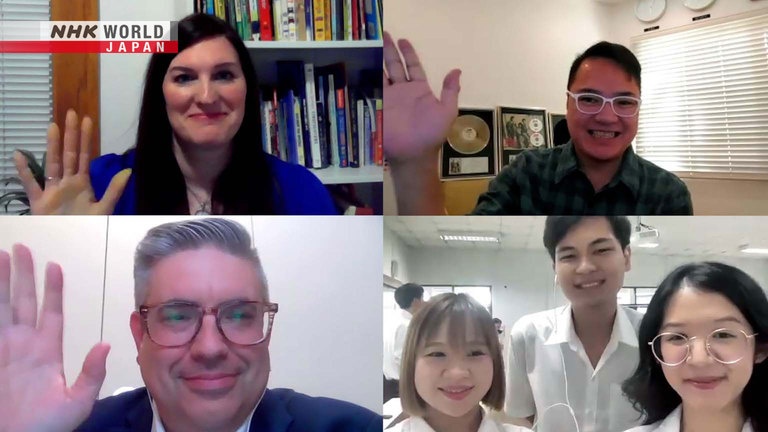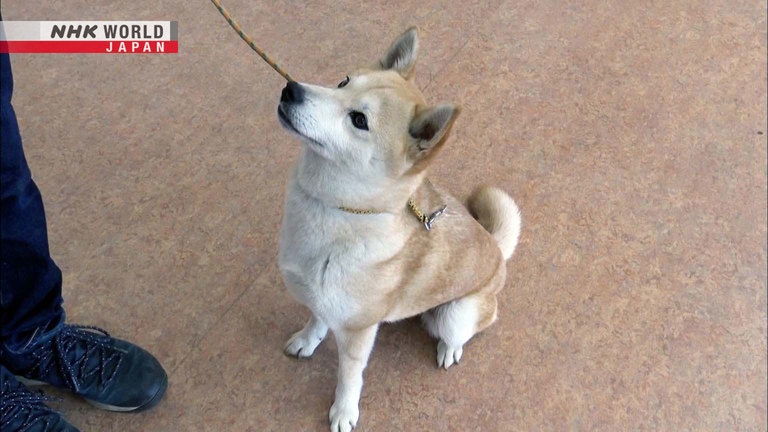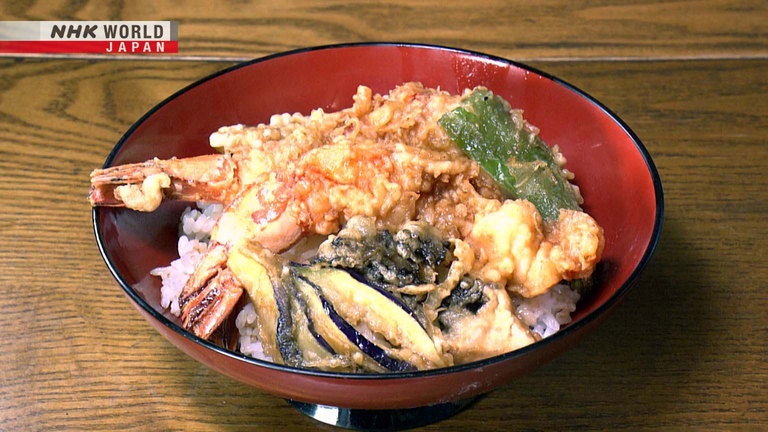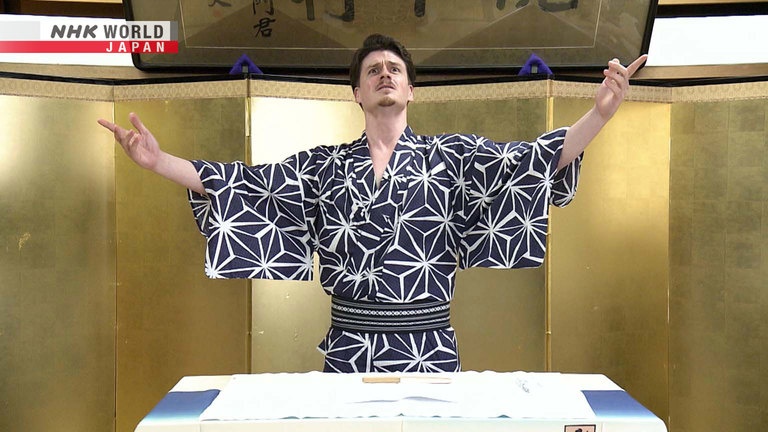20th Anniversary Special Part 2
*First broadcast on March 28, 2024.
It's a 20th anniversary special! Presenters and viewers join Peter Barakan to look back at some highlights. Part two features fans from around the world discussing great moments from the show's past.




Transcript
Japanology Plus
Japanology 20th Anniversary Special
Part 2
Hello. Welcome back to our second
look back at some of the episodes of
Japanology Plus and
Weekend Japanology and BEGIN Japanology
that have been broadcast
over the last 20 years.
And we're going to have the videos
arranged in four different groups again,
same as last time.
It'll be nature, food, daily life,
and art and culture.
In part two of our
20th anniversary special,
Peter is joined by presenters
Kyle and Matt, narrator Emma...
and some really serious Japanology fans
participating remotely
from around the world.
First, we'll speak to Rachel Henderson,
a Japanese teacher at
a high school in Iowa, USA.
She has long used
Japanology programs in her lessons,
and on one occasion, Peter himself
did an online session with her students.
How many years ago was it
that I did my session
with the students from Cedar Rapids?
So, that was 2019.
And I have to tell you, we made that day
that we did that with you,
that became Peter Barakan Day.
So, that is forever etched
in our history of Jefferson.
So it was a special day for all of us.
How did you come to start using
Japanology episodes in your teaching?
Yeah, when I started
teaching 15 years ago,
I just knew I needed to show these kids
videos of bringing, you know,
Japanese culture to life.
Because I can just talk
and they can listen,
but until they actually see it, you know,
they're not going to really know
what I'm talking about.
So it was the... my go-to videos from
that point on and until today that...
how much information
it has for these students
is just a completely invaluable
tool for my teaching.
Right.
Next up is James Coronel from Manila.
Hi, Mr. Barakan and Ms. Emma,
I'm James Coronel from
Smokey Mountain singing group,
and I'm here right now in the Philippines.
James Coronel is a musician and producer
joining us from the Philippines.
While performing
in the group Smokey Mountain,
he visited Japan and acquired
an interest in Japanese culture.
I can see you've got
a gold record behind you.
Actually, Peter, it's a platinum.
Platinum.
I apologize.
Congratulations.
And next up is Don Smith from Maryland,
on the outskirts of Washington, D.C.
Exactly. Yeah, it's an honor.
It's an honor to meet you,
Mr. Barakan, very much.
Don Smith, from Maryland, USA,
has been a dedicated viewer for
Japanology's entire 20-year history.
I understand you
and Matt already know each other.
Yes, we do.
It's very true. As coincidental as it is,
I was watching Weekend Japanology
and BEGIN Japanology
well before Japanology Plus.
But Matt and I are pretty much
from the same neighborhood,
and we even have some mutual friends.
Wow. Okay.
And our final group of guests are from
Bangkok, and they're university students.
Hello.
Hi.
Well, thank you for joining us.
The trio study at
Srinakharinwirot University
in Bangkok, Thailand.
Are you all studying Japanese?
Yes, we are. We do study
in a Japanese program
and last week we watched Japanology
about the cardboard box.
Okay. Great.
Alright, let's move on to
the first group of videos.
This time, they're all from
the Japanology Plus era,
which means over the last ten years or so.
And these ones are about nature.
Animals & Nature
First, onsen: hot spring baths.
Japan ranks high among
the world's hot spring hot spots.
One example of a coastal onsen
can be found in the city of Hakodate
in southern Hokkaido.
It makes ingenious use
of natural rock formations.
But timing is crucial for
bathers at this rotenburo.
At low tide, the pools are too hot.
It’s hot.
But when the tide is high,
seawater flows in,
mixing with the hot spring water to
cool it to a comfortable temperature.
Hot spring water isn't always clear.
These baths in Kumamoto
are completely opaque.
The mineral-rich mud that clouds
the water comes directly from the source.
It's known for a strong warming
effect and for nourishing the skin.
This next episode focused
on Japanese dog breeds.
Japanese dogs obey only their master.
Let's compare their behavior with Western
dog breeds and examine the difference.
Peter will meet some
dogs for the first time.
There are different dogs.
He'll call out to each of them in turn.
How will the Japanese
and Western dogs' responses differ?
This is Kokoro,
a six-year-old female Chihuahua.
How will she respond?
Peter waits inside the room.
The dogs will eat him.
Hello. You're going to
be my friend, then? Hello.
Kokoro makes a beeline for him
the moment the door is opened.
Cute.
Matt: That's a lap dog.
Now, let's see how Japanese dogs behave.
This is Beni,
a three-year-old female Shiba Inu.
First up is her trainer.
Oh, wow.
She runs over straight away.
And she follows his commands.
Now, let's see what she thinks of Peter.
Kyle: Do you have treats?
Emma: Let me out!
She sprints over,
but soon has second thoughts
and runs away as fast as she came.
Matt: Where you going?
I have to ask. Did you ever make
friends with that second dog?
Unfortunately not.
Oh, too bad. She looked like a cutie.
Peter: And then we had onsen.
Matt: Yes, the perennial topic.
I think everybody loves onsen.
Emma: Who doesn't?
Kyle: Nothing better than onsen.
Rachel, have you ever experienced onsen?
Actually, that was one of the very first
memories I had when I moved to Japan.
One of my friends in the middle of August
said, “Hey, let's go to an onsen.”
And I couldn't figure out why,
for the life of me,
I'd sit in a vat of hot water
when it was 100 degrees outside.
It didn't make sense
to me at the time, at all.
But later on, we went during wintertime.
And then I realized how wonderful
and awesome onsen were.
And I took my family there
and friends when they came to visit.
And I learned the greatness
of onsen at that point.
Right. Don?
Well, I haven't visited Japan yet
and so BEGIN Japanology
and Japanology Plus
has sort of been my experience there.
And I'll tell you this,
I'm really glad that the episode discussed
all the onsen etiquette
because otherwise, I think I could make
mistakes and really end up in hot water.
I see what you did there.
Okay, let's move on to
our next group of videos.
And this time it's food.
Food & Drink
This episode was about frozen food.
Japan has many different
types to choose from.
Here's a selection featuring rice.
Fried rice is especially popular.
In fact, the market for frozen fried rice
generates annual sales of 15 billion yen.
And makers compete fiercely.
But the biggest seller among
frozen foods is pasta.
There's a wide variety with over
100 products on the market.
Matt: I had no idea.
Kyle: That's a lot of pasta.
This pack features six frozen side dishes
designed to be the perfect
size for use in bento.
They can be added as is.
By lunchtime, they'll have thawed
and will be ready to eat.
Today's lunch features chilled noodles,
a new frozen food product.
The noodles are covered in pieces of ice.
Kyle: Curious.
The meal is microwaved
for around 3 minutes.
While the noodles get hot,
the ice is unaffected.
But now it melts to chill the noodles.
Add the toppings and the dish is complete.
Bento, Japanese boxed lunches,
are now popular around the world.
Rice, main items, and side dishes are
the three typical elements of a bento.
Rice has carbohydrates, for energy.
The main items will include
the likes of meat, fish, and eggs...
things rich in protein to build the body.
The side dishes will be vegetables,
mushrooms, seaweed:
foods packed with healthy vitamins,
minerals, and fiber.
In Japan, it's easy
to find shops selling bento.
Convenience stores stock a wide selection.
They compete to develop
the best possible meals.
Tasty bento are a crucial way
to get customers into a shop.
Right now, there is a huge fad in Japan
for arranging the food in bento
to look like cartoon characters.
Many people blog proudly about
their “character bento” creations.
The faces of the characters
are the most important.
First, Fujita cuts a sheet
of nori seaweed to make hair.
This is placed on a slice of ham
that will become the face.
The details like eyes and mouth
are made using shape cutters.
In no time at all, the image
of a girl has appeared!
60 percent of Japanese people eat
a donburi rice bowl every week.
Let's see some varieties.
First, unadon.
The topping is grilled eel,
coated with sweetened soy sauce.
A lot of people eat it as a way to cope
with the exhausting heat of summer.
Here's tendon.
The topping is seafood
and vegetable tempura.
This is katsudon.
Breaded pork cutlet is cooked
together with stock and egg.
Egg is a feature of various
rice bowl dishes.
Frozen food, bento, and don.
Donburi.
Peter: I'll go for donburi.
Emma: I'll go for donburi any day.
Always donburi. Every time.
Although I have to say,
I was really surprised
at the sheer variety of frozen foods here.
Yeah.
The pastas alone were...
The pastas had never even occurred to me.
And the thing with the ice cubes,
that was...that's really ingenious.
That's amazing.
- It was ingenious, wasn't it?
- Yes. Ingenious.
Okay, let's ask our guests
their opinions about these too.
Shall we start with Don this time?
So, Don, I have to ask,
what's your favorite donburi?
Tekkadon.
Tekkadon? Okay, with maguro.
So can you get tendon,
my favorite, over there?
We can. We can get tendon.
I've seen oyakodon,
the parent and child bowl, as well,
which definitely surprised me when
I first understood what that meant.
Kyle: Lovely naming.
Peter: Egg and chicken,
for the uninitiated.
Exactly. But I think of all the food
episodes, it is for me that bento episode
because my kids were in elementary
school when it first came on and I said,
I can do this, I can do this at home
and I can have them, you know,
bring a little bento box
with a panda bear rice ball
with little nori cut for ears
and maybe a little sausage
cut to look like an octopus.
And it was something that kind
of brought us all together
and helped the kids understand the way
other cultures live around the world.
Interesting. Okay, Rachel, bento...is that
something you see in your school?
Not really. And I'm
on the opposite end of Don,
where I'm just like, I love you, my son,
but I will not take the time to do that.
I'm not artistic,
so you'll just get a sandwich.
But you know,
when I'm teaching my students,
I definitely talk about the bento
because, you know, in that episode
it talks about the history of it,
and how this custom has been going
on for hundreds and hundreds of years.
And I think that's so valuable for
the students to understand that.
Just from a lunchbox, you can get
so much about the Japanese, you know,
psyche of what are we looking at?
How is it pleasing to the eye,
the aesthetic, the art that's with it?
That's kind of this food culture
that's very different from
the American kind of food culture.
And I think that's worth
the learning and kind of studying.
Okay.
And now our students in Bangkok.
I would like to taste bento.
It's like a food that shows
a mother's affection to their child
and it's really good.
I want to taste one and I want
my mom to make me one.
Life & Lifestyle
Our “life & lifestyle”-themed episodes
start with an introduction to tiny houses.
Each of them is home to a family of three.
Two parents and a daughter.
The first house occupies
just 23 square meters
on a rectangular plot
that's three meters wide.
Welcome.
Directly opposite
the front door is a bedroom
with furniture at a minimum.
There's space for the parents
to sleep comfortably.
On the other side of this
wall is a staircase.
Underneath it is a storage
area and a toilet.
Compact houses take advantage of
any available space, no matter how small.
This toilet, for example,
fits perfectly under the stairs.
Upstairs is a living and dining area
where the family can relax
and enjoy each other's company.
This area has a surprisingly high ceiling.
Design choices like this
create a sense of openness.
They're a common feature of tiny houses.
The spiral staircase leads to an attic.
It acts as a bedroom for
the daughter of the family
and offers room for even more storage.
Japan is known around the world
for its high-tech toilets.
Most sit-down toilets made these
days have numerous features.
The most famous are
a heated seat and built-in bidet.
At the push of a button, a nozzle extends
and sprays warm water to wash the user.
Kyle: Oh, that's a good one.
Here, the lid lifts automatically
when you approach.
The user doesn't have to touch it.
The toilet also flushes automatically
when the user stands up.
It senses the type of waste
and adjusts the amount of water
for the flush accordingly.
That's brilliant.
Kyle: My toilet doesn't do that.
Yeah, I have a cheap one.
Some toilets have features
that make them easier to clean.
This entire section lifts up so that
hard-to-clean areas can be reached.
I still don't want to clean it, though.
Matt: Yeah, there's that, yeah.
At a driving school, Peter tried driving
uphill using a manual transmission.
Oh, it's a stick shift?
I screwed up so badly.
I can only... only automatic for me.
Please drive up the hill,
stop midway and then start again.
Peter usually drives an automatic.
It's been a long time since he drove
a car with a manual transmission.
Will he manage?
Please start.
I forgot.
Caught on camera.
Sorry about that.
This episode was about ocean fishing.
Matt: Thank God we didn't have
to go out in the ocean boat.
Matt Alt went in search of
an unusual-looking sea creature.
First, tell me, what is the fish
that we're going to take today?
Well, here's what it looks like dried.
This looks like a little alien.
Actually, they say that it
did inspire the movie Alien.
It lives out there in the tidal flats.
The board that Matt is using to slide
over the deep mud is three meters long.
It's not easy to make it go straight.
Matt: It's tough to steer.
What should we be looking for when
we're trying to catch these fish?
An eel goby burrow has a hole at each end,
so you push your pole down
in between the two holes.
And then you use this device.
You dig around with this hook.
Yeah. It took us hours to find one.
We were out of season.
And there you are.
You did it! You got one!
They head further out to
the place where Matt will try.
After an hour of hunting for an eel goby,
Matt has hooked... something.
Something, something.
What is...?
A plastic bag.
Kyle: You did your part.
Matt: I did.
Oh, so this is the creature.
The face really looks like an alien.
Oh, that thing bit me so bad.
Kyle: Oh no no no, don't do it.
Kyle: Why did you do it?
Why did you do it?
It does hurt!
- What a moment to end it on.
- You put your finger in its mouth.
I had to try.
Why would you do that?
I had to try. It was that gaping jaw.
It was just... It was almost
like it was calling me.
Well, it wasn't quite
as embarrassing as me in the car.
Yeah well, that was pretty interesting.
I noticed your instructor
was so stony-faced.
He's like, “Who have they
put me in the car with?”
Tiny houses was a really popular episode.
I was amazed when I was told
how many people had watched that.
Well you narrated it,
so of course, you know it.
Yeah. I mean it's fascinating, these
tiny spaces that are so well-utilized.
So let's ask our guests as well.
What did you think about those videos?
I like most is the toilet.
From now I am still student,
but I think if I had... if I had a job and
I create a house, I will buy for sure.
Okay.
James in Manila.
Yes. The driving school.
Of course, my group wants
to go back to Japan,
but hopefully Peter will not
drive us in a manual shift car.
Thank you.
And let's go to our last
group of videos now.
And these are on art and culture.
Art & Culture
Japanology Plus introduced a new,
artistic take on tatami mats.
Yamada Kenji is the fifth-generation owner
of a tatami business in Gifu Prefecture.
He's staking its survival on
the success of a creative innovation.
He came up with designs
featuring irregular polygons
and circular motifs.
He makes use of a key feature of tatami.
Its visual impact varies with
the direction from which it is viewed.
This design appears to feature
hexagonal mats in three different colors.
Together, they form
an image of Marilyn Monroe.
But in truth, each mat is identical.
They are simply rotated
to create a special effect.
Their weaves run in different directions,
so they catch the light differently.
Here's an even more intricate design.
A dragon.
Next, rokyoku, a traditional
Japanese performing art.
Rokyoku features singing
and also spoken storytelling.
The roles are all performed by
one person known as a rokyokushi.
Matt: There you are.
Kyle Card learned the basics.
“First this and then that.”
“One thing led to another,
then this happened.”
And here's how you should perform it.
Emma: This is quite fun to watch.
- Too much.
- Ah, too much.
Let's see what he's learned.
Thank you for coming.
I offer you a warm welcome!
I will perform Kyle's Story,
and so let's begin.
Good job!
First this and then that.
One thing led to another,
then this happened.
That's all we have time for.
So I'll stop here.
That is seriously impressive.
Thank you.
You looked like you were really
enjoying yourself, as well.
It was very fun, and she was just amazing.
But it just left me really
humbled to know that
no matter how good I get at Japanese,
there's always going to be this level
that is unfathomable to me
that I can never reach.
That's a whole different world.
I'm really,
really impressed by the rokyoku.
I think I want to learn it, too.
The rokyoku.
Good luck. It's very difficult.
Matt: Very unique delivery.
Very fun though.
Right. Don?
Sure. I loved the material
for the tatami presentation.
And one of the things that I find
so fascinating with tatami
is that it's not just,
you know, a material,
and it's not just art that we got to see.
But it also ended up being that
unit of measurement for rooms,
which is a completely different
way of looking at rooms
than simply the United States
way of saying “eight by ten.”
You could say it's five tatami mats.
And I think that's very
interesting in the way that
material culture can be used
to shape your environment.
Interesting observation.
Yes, because we've
all lived here for so long
that we totally take that for granted.
But talking about an eight-mat room
or a ten-mat room
for anybody outside of Japan is,
“What?”
Okay. Thank you, Don.
Thank you.
We do cover a lot of different
topics on this program.
And it continues.
I mean this time and last time
we've been looking back over some
of the videos from the last 20 years,
but starting from next time,
we'll be doing some new episodes as well.
So please stay with us for those as well.
And all of you, James, Don, Rachel,
and students in Bangkok,
thank you all for taking
part in the show today
and I hope you'll continue watching.
So thank you, all three of you,
for joining me for these.
Kyle: Thanks for having us.
Matt: Always a pleasure.
So see you 20 years from now.
We have to do this again.